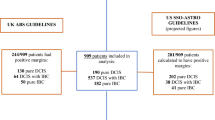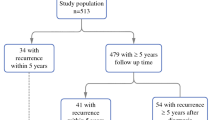Abstract
Background
It has been suggested that selective sentinel node (SN) biopsy alone can be used to manage early breast cancer, but definite evidence to support this notion is lacking. The aim of this study was to investigate whether refraining from completion axillary lymph node dissection (ALND) suffices to produce the same prognostic information and disease control as proceeding with completion ALND in early breast cancer patients showing micrometastasis at SN biopsy.
Methods
This prospective, randomized clinical trial included patients with newly diagnosed early-stage breast cancer (T < 3.5 cm, clinical N0, M0) who underwent surgical excision as primary treatment. All had micrometastatic SN. Patients were randomly assigned to one of the two study arms: complete ALND (control arm) or clinical follow-up (experimental arm). Median follow-up was 5 years, recurrence was assessed, and the primary end point was disease-free survival.
Results
From a total sample of 247 patients, 14 withdrew, leaving 112 in the control arm and 121 in the experimental arm. In 15 control subjects (13 %), completion ALND was positive, with a low tumor burden. Four patients experienced disease recurrence: 1 (1 %) of 108 control subjects and 3 (2.5 %) of 119 experimental patients. There were no differences in disease-free survival (p = 0.325) between arms and no cancer-related deaths.
Conclusions
Our results strongly suggest that in early breast cancer patients with SN micrometastasis, selective SN lymphadenectomy suffices to control locoregional and distant disease, with no significant effects on survival.


Similar content being viewed by others
References
Reynolds C, Mick R, Donohue JH, Grant CS, Farley DR, Callans LS, et al. Sentinel lymph node biopsy with metastasis: can axillary dissection be avoided in some patients with breast cancer? J Clin Oncol. 1999;17:1720–6.
Chu KU, Turner RR, Hansen NM, Brennan MB, Bilchik A, Giuliano AE. Do all patients with sentinel node metastasis from breast carcinoma need complete axillary node dissection? Ann Surg. 1999;229:536–41.
Cserni G, Gregori D, Merletti F, Sapino A, Mano MP, Ponti A, et al. Meta-analysis of non-sentinel node metastases associated with micrometastatic sentinel nodes in breast cancer. Br J Surg. 2004;91:1245–52.
Fant JS, Grant MD, Knox SM, Livingston SA, Ridl K, Jones RC, et al. Preliminary outcome analysis in patients with breast cancer and a positive sentinel lymph node who declined axillary dissection. Ann Surg Oncol. 2003;10:126–30.
Hwang RF, Gonzalez-Angulo AM, Yi M, Buchholz TA, Meric-Bernstam F, Kuerer HM, et al. Low locoregional failure rates in selected breast cancer patients with tumor-positive sentinel lymph nodes who do not undergo completion axillary dissection. Cancer. 2007;110:723–30.
Guenther JM, Hansen NM, DiFronzo LA, Giuliano AE, Collins JC, Grube BL, et al. Axillary dissection is not required for all patients with breast cancer and positive sentinel nodes. Arch Surg. 2003;138:52–5.
Cox CE, Kiluk JV, Riker AI, Cox JM, Allred N, Ramos DC, et al. Significance of sentinel lymph node micrometastases in human breast cancer. J Am Coll Surg. 2008;206:261–8.
Maaskant-Braat AJ, van de Poll-Franse LV, Voogd AC, Coebergh JW, Nolthenius-Puylaert MCT, Nieuwenhuijzen GA. Sentinel node micrometastases in breast cancer do not affect prognosis: a population-based study. Breast Cancer Res Treat. 2010;127:195–203.
Galimberti V, Botteri E, Chifu C, Gentilini O, Luini A, Intra M, et al. Can we avoid axillary dissection in the micrometastatic sentinel node in breast cancer? Breast Cancer Res Treat. 2012;131:819–25.
Langer I, Marti WR, Guller U, Moch H, Harder F, Oertli D, et al. Axillary recurrence rate in breast cancer patients with negative sentinel lymph node (SLN) or SLN micrometastases: prospective analysis of 150 patients after SLN biopsy. Ann Surg. 2005;241:152–8.
Gobardhan PD, Elias SG, Madsen EV, Bongers V, Ruitenberg HJM, Perre CI, et al. Prognostic value of lymph node micrometastases in breast cancer: a multicenter cohort study. Ann Surg Oncol. 2011;18:1657–64.
Yegiyants S, Romero LM, Haigh PI, DiFronzo LA. Completion axillary lymph node dissection not required for regional control in patients with breast cancer who have micrometastases in a sentinel node. Arch Surg. 2010;145:564–9.
Fleming ID, Cooper JS, Henson DE. AJCC cancer staging manual. 4th ed. Philadelphia: Lippincott-Raven; 1997.
Greene FL, Page DL, Fleming ID. AJCC cancer staging manual. 6th ed. New York: Springer; 2002.
Neville AM, Price KN, Gelber RD, Goldhirsh A. Axillary node micrometastases and breast cancer. Lancet. 1991;337:1110.
Goldhirsch A, Wood WC, Gelber RD, Coates AS, Thürlimann B, Senn HJ. Meeting highlights: updated international expert consensus on the primary therapy of early breast cancer. J Clin Oncol. 2003;21:3357–65.
Giuliano AE, Dale PS, Turner RR, Morton DL, Evans SW, Krasne DL. Improved axillary staging of breast cancer with sentinel lymphadenectomy. Ann Surg. 1995;22:394–9.
Schreiber RH, Pendas S, Ku NN, Reintgen DS, Shons AR, Berman C, et al. Microstaging of breast cancer patients using cytokeratin staining of the sentinel node. Ann Surg Oncol. 1999;6:95–101.
Jemal A, Ward E, Thun MJ. Recent trends in breast cancer incidence rates by age and tumor characteristics among U.S. women. Breast Cancer Res. 2007;9:R28.
Cronin-Fenton DP, Ries LA, Clegg LX, Edwards BK. Rising incidence rates of breast carcinoma with micrometastatic lymph node involvement. J Natl Cancer Inst. 2007;99:1044–9.
Recht A, Houlihan MJ. Axillary lymph nodes and breast cancer. Cancer. 1995;76:1491–512.
Naik AM, Fey J, Gemignani M, Heerdt A, Montgomery L, Petrek J, et al. The risk of axillary relapse after sentinel lymph node biopsy for breast cancer is comparable with that of axillary lymph node dissection: a follow-up study of 4008 procedures. Ann Surg. 2004;240:462–8.
Saidi RF, Dudrick PS, Remine SG, Mittal VK. Nonsentinel lymph node status after positive sentinel lymph node biopsy in early breast cancer. Am Surg. 2004;70:101–5.
Leidenius MHK, Vironen JH, Riihela MS, Krogerus LA, Toivonen TS, von Smitten KAJ, et al. The prevalence of non-sentinel node metastases in breast cancer patients with sentinel node micrometastases. Eur J Surg Oncol. 2005;31:13–8.
Fraile M, Rull M, Julian FJ, Fuste F, Barnadas A, Llatjos M, et al. Sentinel node biopsy as a practical alternative to axillary lymph node dissection in breast cancer patients: an approach to its validity. Ann Oncol. 2000;11:701–5.
Cserni G, Amendoira I, Apostolikas N, et al.; European Working Group for Breast Screening Pathology. Pathological work-up of sentinel lymph nodes in breast cancer. Review of current data to be considered for the formulation of guidelines. Eur J Cancer. 2003;39:1654–67.
Viale G, Zurrida S, Maiorano E, Mazzarol G, Pruneri G, Paganelli G, et al. Predicting the status of axillary sentinel lymph nodes in 4351 patients with invasive breast carcinoma treated in a single institution. Cancer. 2005;103:492–500.
Viale G, Maiorano E, Mazzarol G, Zurrida S, Galimberti V, Luini A, et al. Histologic detection and clinical implications of micrometastases in axillary sentinel lymph nodes for patients with breast carcinoma. Cancer. 2001;92:1378–84.
Ganaraj A, Kuhn JA, Jones RC, Grant MD, Andrews VR, Knox SM, et al. Predictors for non sentinel involvement in breast cancer patients with micrometastases in the sentinel node. Proc Bayl Univ Med Cent. 2003;16:3–6.
Giuliano AE, Hunt KK, Ballman KV, Beitsch PD, Whitworth PW, Blumencranz PW, et al. Axillary dissection vs. no axillary dissection in women with invasive breast cancer and sentinel node metastasis: a randomized clinical trial. J Am Med Assoc. 2011;305:569–75.
National Comprehensive Cancer Network. NCCN guidelines—breast cancer, version 2.2011. 2011. http://www.nccn.org/professionals/physician_gls/pdf/breast.pdf. Accessed 23 Feb 2011.
ClinicalTrials.gov. Surgical resection with or without axillary lymph node dissection in treating women with node-negative breast cancer and sentinel lymph node micrometastases. NCT00072293. 2012. http://inicaltrials.gov/ct2/show/results/NCT00072293. Accessed 5 July 2012.
Acknowledgment
Supported in part by Grant AATRM 048/13/2000 from the Catalan Agency for Health Information, Assessment and Quality, Barcelona, Spain. We are deeply grateful to all the local researchers and patients who were willing to participate so generously. We especially acknowledge the contribution of Dr. J. M. Gubern (Hospital de Mataró) and Dr. A. Barnadas (Hospital Sant Pau de Barcelona) for their careful review. Our special thanks go to the following investigators, who, together with those cited as authors, also participated in the study: Dr. Jordi Solsona, Hospital del Mar de Barcelona; Dr. Pere Puig, Hospital Sant Jaume de Calella; Dr. Jose L de Pablo, Hospital de Txagorritxu de Vitoria; Dr. Guadalupe Peñalva, Fundació Hospital Assil de Granollers; Dr. Ricardo Rojo, Hospital Ramón y Cajal de Madrid; Dr. Joan Janer, Hospital de l’Esperit Sant de Santa Coloma de Gramenet; Dr. Josep M Gubern, Hospital de Mataró; Dr. Pere Deulofeu, Hospital Municipal de Badalona; Dr. Enrique Veloso, Hospital Mutua de Terrassa; Dr. Constantí Serra, Hospital General de Vic; Dr. Luis Solarnau, ALTHAIA–Xarxa Assistencial de Manresa. This study corresponds to a substantial part of a doctoral thesis that will be presented at Autonomous University of Barcelona.
Author information
Authors and Affiliations
Corresponding author
Rights and permissions
About this article
Cite this article
Solá, M., Alberro, J.A., Fraile, M. et al. Complete Axillary Lymph Node Dissection Versus Clinical Follow-up in Breast Cancer Patients with Sentinel Node Micrometastasis: Final Results from the Multicenter Clinical Trial AATRM 048/13/2000. Ann Surg Oncol 20, 120–127 (2013). https://doi.org/10.1245/s10434-012-2569-y
Received:
Published:
Issue Date:
DOI: https://doi.org/10.1245/s10434-012-2569-y




